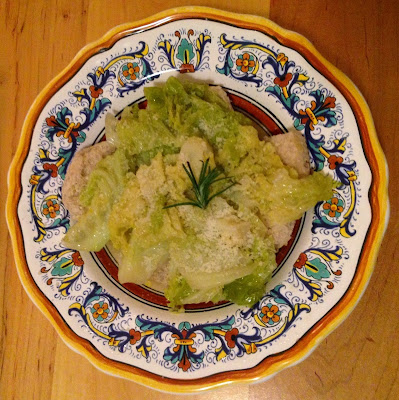| Che dite di questo pasto:
Verza,
lessata nel brodo casereccio d’agnello,
sopra pane francese,
con una spolverata di pecorino romano frescamente grattugiato
Se io fossi il Re, io non sarei imbarazzato dalla comparsa di questo piatto davanti a me.
La realtà è che questo è stato un piatto di avanzi. Cianfrusaglie. Scarti. Già sapete, cari lettori e lettrici, che il mio freezer contiene sempre gli scarti per il brodo. L’intorno del picciolo di un pomodoro. I gambi di un grumolo di finocchio. Il torsolo di una testa di scarola. L’estremità di una cipolla. Una crosta di parmigiano reggiano. Et alia. (Vedete qua per la ricetta completa del brodo.) In questo caso, il frigo conteneva qualcosa anche più preziosa: l’osso della gamba dell’agnello pasquale! Un’altro avanzo pasquale era il pane “francese”, che secondo la confezione sia francese. Ma era mica francese questo. Quest’era il pane cafone amato da tutti i napoletani del mondo – l’esterno croccante, l’interno pieno di quei grandi buchi. Ormai il pane era raffermo, ovviamente. Ma che cosa è più gloriosa della trasformazione del pane raffermo che capita nella cucina cafonesca?! Pertanto, iniziamo con questo pane cafone raffermo. Sopra di quello, un filo d’olio d’oliva italiano extravergine. Sopra di quello, la verza che si è lessata per 15 minuti nel brodo d’agnello pasquale e degli scarti del freezer. Sopra di quello, il pecorino fresco. Si mangia, e quando si raggiunge il pane, è adesso tenero, inzuppato dal brodo e dall’olio. Sicuramente il Re non ha mangiato questo oggi. Povero lui. | What do you say about this meal:
Savoy cabbage,,
cooked in homemade lamb stock,
over Francese bread,
with a dusting of freshly grated
pecorino romano
If I were the King, I would not be embarrassed by the appearance of this dish before me.
The reality is that it was a dish of leftovers. Odds and ends. Scraps.
My readers already know that my freezer always contains scraps for stock. The part of the tomato around the stem. The stalks of a bulb of fennel. The core of a head of escarole. The top of an onion. A hard end of parmigiano reggiano. And so forth. (See here for the complete stock recipe.) In this case, the fridge contained something even more precious: the bone from the Easter leg of lamb! Another Easter leftover was the "French" bread, which according to the package was French. But it was hardly French. This was pane cafone, the peasant bread beloved by all the Neapolitans around the world – the crusty outside, the inside filled with those big holes. By now the bread was stale, obviously. But what is more glorious than the transformation of stale bread that occurs in the peasant kitchen?! Therefore, we begin with this stale peasant bread. On top of that, a drizzle of Italian extra-virgin olive oil. On top of that, the savoy cabbage which cooked for 15 minutes in the stock made from the Easter lamb and the scraps from the freezer. On top of that, the fresh pecorino. You eat, and when you reach the bread, it is now tender, saturated with the broth and oil. Surely the King didn't eat this today. Poor guy. |
Diario dell’Esperienza Italoamericana
A Journal of the Italian-American Experience
sabato 11 aprile 2015
Il Re mangia gli scarti / The King eats scraps
Iscriviti a:
Commenti sul post (Atom)



Ottimo piatto!!!!! Che dire? Povero il Re!
RispondiElimina